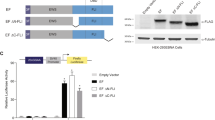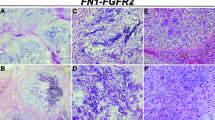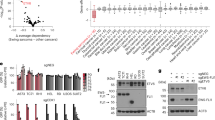Abstract
The EWS/TEC gene fusion generated by the t(9;22) chromosomal translocation found in extraskeletal myxoid chondrosarcomas encodes a fusion protein containing the amino-terminal domain of the EWS protein fused to the whole coding sequence of the orphan nuclear receptor TEC. We have compared the DNA-binding and transcriptional activation properties of various TEC isoforms and the corresponding EWS/TEC fusion proteins. Band-shift experiments show that the full-length TEC receptor can efficiently bind the NGFI-B Response Element (NBRE), whereas an isoform lacking the entire carboxyl-terminal domain of the receptor binds much less efficiently the NBRE. Addition of the amino-terminal domain of EWS to either isoforms does not alter significantly their DNA-binding properties to the NBRE. Co-transfection experiments of COS cells and human chondrocytes indicate that whereas TEC moderately activates transcription from a NBRE-containing promoter, the corresponding EWS/TEC fusion protein is a highly potent transcriptional activator of the same promoter, being approximately 270-fold more active than the native receptor. EWS/TEC may thus exert its oncogenic potential in chrondrosarcomas by activating the transcription of target genes involved in cell proliferation.
This is a preview of subscription content, access via your institution
Access options
Subscribe to this journal
Receive 50 print issues and online access
$259.00 per year
only $5.18 per issue
Buy this article
- Purchase on Springer Link
- Instant access to full article PDF
Prices may be subject to local taxes which are calculated during checkout





Similar content being viewed by others
References
Bailly RA, Bosselut R, Zucman J, Cormier F, Delattre O, Roussel M, Thomas G and Ghysdael J. . 1994 Mol. Cell. Biol. 14: 3230–3241.
Bertolotti A, Melot T, Acker J, Vigneron M, Delattre O and Tora L. . 1998 Mol. Cell. Biol. 18: 1489–1497.
Brody RI, Ueda T, Hamelin A, Jhanwar SC, Bridge JA, Healey JH, Huvos AG, Gerald WL and Ladanyi M. . 1997 Am. J. Pathol. 150: 1049–1058.
Buono P, Deconciliis L, Izzo P and Salvatore F. . 1997 Biochem. J. 323: 245–250.
Calvio C, Neubauer G, Mann M and Lamond AI. . 1995 RNA 1: 724–733.
Castillo SO, Xiao Q, Lyu MS, Kozak CA and Nikodem VM. . 1997 Genomics 41: 250–257.
Clark J, Benjamin H, Gill S, Sidhar S, Goodwin G, Crew J, Gusterson BA, Shipley J and Cooper CS. . 1996 Oncogene 12: 229–235.
Delattre O, Zucman J, Plougastel B, Desmaze C, Melot T, Peter M, Kovar H, Joubert I, de Jong P, Rouleau G, Aurias A and Thomas G. . 1992 Nature 359: 162–165.
Fujimura Y, Ohno T, Siddique H, Lee L, Rao VN and Reddy ESP. . 1996 Oncogene 12: 159–167.
Goldring MB, Birkhead JR, Suen LF, Yamin R, Mizuno S, Glowacki J, Arbiser JL and Apperley JF. . 1994 J. Clin. Invest. 94: 2307–2316.
Graham FL and van der Eb AJ. . 1973 Virology 52: 456–467.
Hedvat CV and Irving SG. . 1995 Mol. Endocrinol. 9: 1692–1700.
Jeon IN, Davis JN, Braun BS, Sublett JE, Roussel MF, Denny CT and Shapiro DN. . 1995 Oncogene 10: 1229–1234.
Kaneko Y, Yoshida K, Handa M, Toyoda Y, Nishihira H, Tanaka Y, Sasaki Y, Ishida S, Higashino F and Fujinaga K. . 1996 Genes Chromosom. Cancer 15: 115–121.
Labelle Y, Zucman J, Stenman G, Kindblom LG, Knight J, Turc-Carel C, Dockhorn-Dworniczak B, Mandahl N, Desmaze C, Peter M, Aurias A, Delattre O and Thomas G. . 1995 Hum. Mol. Genet. 4: 2219–2226.
Ladanyi M and Gerald W. . 1994 Cancer Res. 54: 2837–2840.
Law SW, Conneely OM, DeMayo FJ and O'Malley BW. . 1992 Mol. Endocrinol. 6: 2129–2135.
Lessnick SL, Braun BS, Denny CT and May WA. . 1995 Oncogene 10: 423–431.
Lin HH, Tu ZJ and Ann DK. . 1996 J. Biol. Chem. 271: 27637–27644.
May WA, Lessnick SL, Braun BS, Klemsz M, Lewis BC, Lunsford LB, Hromas R and Denny CT. . 1993 Mol. Cell. Biol. 13: 7393–7398.
Milbrandt J. . 1988 Neuron 1: 183–188.
Ohkura N, Hijikuro M, Yamamoto A and Miki K. . 1994 Biochem. Biophys. Res. Commun. 205: 1959–1965.
Ohkura N, Ito M, Tsukada T, Sasaki K, Yamaguchi K and Miki K. . 1996 Biochim. Biophys. Acta 1308: 205–214.
Ohno T, Rao VN and Reddy ESP. . 1993 Cancer Res. 53: 5859–5863.
Ohno T, Ouchida M, Lee L, Gatalica Z, Rao VN and Reddy ESP. . 1994).9: 3087–3097.
Panagopoulos I, Höglund M, Mertens F, Mandahl N, Mitelman F and Aman P. . 1996 Oncogene 12: 489–494.
Peter M, Couturier J, Pacquement H, Michon J, Thomas G, Magdelenat H and Delattre O. . 1997 Oncogene 14: 1159–1164.
Scearce LM, Laz TM, Hazel TG, Lau LF and Taub R. . 1993 J. Biol. Chem. 268: 8855–8861.
Sorensen PHB, Lessnick SL, Lopez-Terrada D, Liu XF, Triche TJ and Denny CT. . 1994 Nature Genet. 6: 146–151.
Urano F, Umezawa A, Hong W, Kikuchi H and Hata J. . 1996 Biochem. Biophys. Res. Commun. 219: 608–612.
Wilson TE, Fahrner TJ, Johnston M and Milbrandt J. . 1991 Science 252: 1296–1300.
Wilson TE, Fahrner TJ and Milbrandt J. . 1993a Mol. Cell. Biol. 13: 5794–5804.
Wilson TE, Mouw AR, Weaver CA, Milbrandt J and Parker KL. . 1993b Mol. Cell. Biol. 13: 861–868.
Zipfel PF, Irving SG, Kelly K and Siebenlist U. . 1989 Mol. Cell. Biol. 9: 1041–1048.
Zucman J, Melot T, Desmaze C, Ghysdael J, Plougastel B, Peter M, Zucker JM, Triche TJ, Sheer D, Turc-Carel C, Ambros P, Combaret V, Lenoir G, Aurias A, Thomas G and Delattre O. . 1993a EMBO J. 12: 4481–4487.
Zucman J, Delattre O, Desmaze C, Epstein AL, Stenman G, Speleman F, Fletchers CDM, Aurias A and Thomas G. . 1993b Nature Genet. 4: 341–344.
Acknowledgements
We thank J Milbrandt for the p(B1a)8-Luc vector and EW Khandjian for critical reading of the manuscript. This work was supported by a grant from the Medical Research Council of Canada to Yves Labelle (MT-13644). Yves Labelle is the recipient of a junior scientist fellowship from the Fonds de la recherche en santé du Québec, and Frank Courjal was supported by a fellowship from the Ministère de l'Education du Québec.
Author information
Authors and Affiliations
Rights and permissions
About this article
Cite this article
Labelle, Y., Bussières, J., Courjal, F. et al. The EWS/TEC fusion protein encoded by the t(9;22) chromosomal translocation in human chondrosarcomas is a highly potent transcriptional activator. Oncogene 18, 3303–3308 (1999). https://doi.org/10.1038/sj.onc.1202675
Received:
Revised:
Accepted:
Published:
Issue Date:
DOI: https://doi.org/10.1038/sj.onc.1202675
Keywords
This article is cited by
-
INSM1 expression and its diagnostic significance in extraskeletal myxoid chondrosarcoma
Modern Pathology (2018)
-
Pleiotropic effects of moonlighting glyceraldehyde-3-phosphate dehydrogenase (GAPDH) in cancer progression, invasiveness, and metastases
Cancer and Metastasis Reviews (2018)
-
Identification of genes regulated by the EWS/NR4A3 fusion protein in extraskeletal myxoid chondrosarcoma
Tumor Biology (2012)
-
Extraskeletal myxoid chondrosarcoma: a review of 23 patients treated at a single referral center with long-term follow-up
Archives of Orthopaedic and Trauma Surgery (2012)
-
p53 and Nur77/TR3 – transcription factors that directly target mitochondria for cell death induction
Oncogene (2006)



